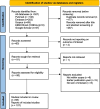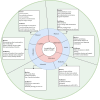Barriers and facilitators of acceptability and uptake of long-acting reversible contraceptives in Ethiopia: a systematic review using the COM-B model
- PMID: 40319326
- PMCID: PMC12048933
- DOI: 10.1186/s13643-025-02827-x
Barriers and facilitators of acceptability and uptake of long-acting reversible contraceptives in Ethiopia: a systematic review using the COM-B model
Abstract
Background: Long-acting reversible contraceptives (LARCs), including implants and intrauterine contraceptive devices (IUCDs), are essential in preventing unintended pregnancies and empowering women by providing long-term, reliable contraception that supports informed decision-making about family planning and reproductive health. However, their uptake and acceptability remain low in Ethiopia due to various individual, social, and systemic barriers. This study systematically reviews the factors influencing LARC acceptability and utilization among Ethiopian women, adolescents, and healthcare providers, using the Capability, Opportunity, Motivation, and Behaviour (COM-B) framework.
Methods: A systematic search of PubMed, Embase, Scopus, African Journals OnLine, and EBSCOhost (CINAHL) was conducted, along with gray literature sources, to identify studies published between January 2021 and June 2024. Inclusion criteria encompassed studies conducted in Ethiopia that examined the acceptability and utilization of LARCs, focusing on implants and IUCDs. The types of studies considered included quantitative, qualitative, and mixed-method designs, focusing on postpartum, post-abortion, and nonpostpartum women, adolescents, and healthcare providers. Data on barriers, facilitators, and associated factors of acceptability and utilization were extracted, and the findings were mapped to the COM-B framework. Atlas.ti v.9 software was used in the analysis process.
Results: A total of 58 cross-sectional, qualitative, and mixed-method studies were included, encompassing diverse Ethiopian populations and geographies. Among immediate and extended postpartum women, barriers included limited awareness and fear of insertion pain for IUCDs, low awareness, and limited access to LARCs, while postpartum counselling emerged as a facilitator. For adolescents, social stigma, male partner disapproval, and misconceptions about LARC side effects were prominent barriers; school-based education and youth-friendly services supported acceptability. Healthcare providers noted inadequate training on family planning methods as a barrier, while targeted training improved their confidence in recommending LARCs. Nonpostpartum women frequently cited partner opposition and cultural beliefs as barriers, but family planning programs with partner engagement facilitated greater acceptance.
Conclusions: The findings highlight an urgent need to expand community-based education programs to dispel myths and misconceptions about LARCs, particularly in rural and pastoral regions. Prioritizing provider training to improve counselling and service delivery, alongside engaging male partners in family planning discussions, is essential for enhancing LARC utilization and meeting reproductive health needs in Ethiopia.
Systematic review registration: PROSPERO CRD42024594288.
Keywords: Acceptability; COM-B framework; Ethiopia; IUCD; Implants; Long-acting reversible contraceptives; Reproductive health; Utilization.
© 2025. The Author(s).
Conflict of interest statement
Declarations. Ethics approval and consent to participate: This review was based solely on published data, with no primary data collection involving human participants, thereby not requiring ethical approval. Additionally, none of the included studies explicitly disclosed financial or nonfinancial conflicts of interest. Consent for publication: Not applicable Competing interests: The authors declare that they have no competing interests.
Figures
Similar articles
-
Magnitude and factors for method discontinuation and switching among long acting reversible contraceptive users in health facilities of Southern Ethiopia.Reprod Health. 2022 Feb 19;19(1):47. doi: 10.1186/s12978-022-01357-2. Reprod Health. 2022. PMID: 35183214 Free PMC article.
-
Canadian Contraception Consensus (Part 2 of 4).J Obstet Gynaecol Can. 2015 Nov;37(11):1033-9. doi: 10.1016/s1701-2163(16)30054-8. J Obstet Gynaecol Can. 2015. PMID: 26629725 English, French.
-
Evaluation of immediate and sustained effects of transitioning quality long-acting reversible contraceptives (LARCs) services to public sector health facilities in Ghana: a pre-post intervention study.Reprod Health. 2025 Mar 20;22(1):41. doi: 10.1186/s12978-025-01979-2. Reprod Health. 2025. PMID: 40114213 Free PMC article.
-
Canadian Contraception Consensus (Part 1 of 4).J Obstet Gynaecol Can. 2015 Oct;37(10):936-42. doi: 10.1016/s1701-2163(16)30033-0. J Obstet Gynaecol Can. 2015. PMID: 26606712 English, French.
-
Acceptability of immediate postpartum and post-abortion long-acting reversible contraception provision to adolescents: A systematic review.Acta Obstet Gynecol Scand. 2021 Apr;100(4):629-640. doi: 10.1111/aogs.14129. Epub 2021 Mar 9. Acta Obstet Gynecol Scand. 2021. PMID: 33608901
References
-
- Secura G. Long-acting reversible contraception: a practical solution to reduce unintended pregnancy. Minerva Ginecol. 2013;65(3):271–7. - PubMed
-
- Stark EL, Gariepy AM, Son M. What is long-acting reversible contraception? JAMA. 2022;328(13):1362–1362. - PubMed
-
- Haileyes, K.G., et al., Myth and misconception about long-acting reversible contraception use among reproductive age group women in Debre Berhan governmental health centers, Ethiopia: qualitative study. 2023. 8(1): e65.
-
- Geberemariam WT, Mekonnen B, Asfaw HM et al. Acceptance of an immediate post-partum intrauterine contraceptive device and associated factors among women who gave birth in public hospitals of Addis Ababa, Ethiopia: A cross-sectional study. June 2024, PREPRINT (Version 1) available at Research Square. 10.21203/rs.3.rs-4429728/v1.
Publication types
MeSH terms
LinkOut - more resources
Full Text Sources



